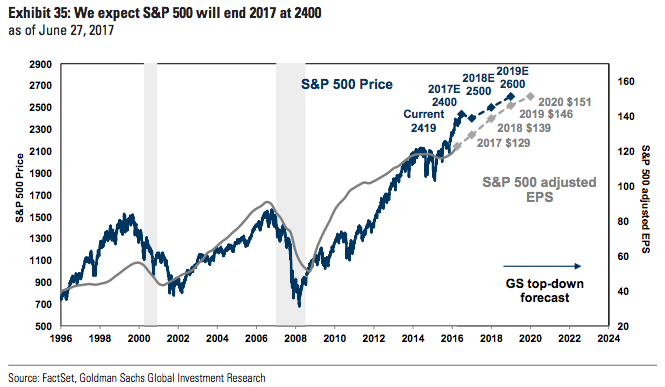The tech stock illuminati leading the market higher are getting too much credit

Getty Images
Bill Gates and Jeff Bezos playing tennis.
There’s no denying that stock market returns have been dominated by an elite group of mega-cap tech stocks over the past few months.
Whether or not those torrid returns are fully justified is another matter entirely.
While so-called FAAMG stocks — Facebook, Amazon, Apple, Microsoft and Google — make up 13% of S&P 500 market cap, they only account for 6% of revenue and 10% of earnings, according to Goldman Sachs data.
Because the group represents such a small portion of revenue, even aggressively strong sales growth for FAAMG will fail to make much of an impact on overall S&P 500 earnings. Goldman finds that a 100-basis-point expansion in net margin for each of the five stocks would produce just 70 total cents of additional earnings for the benchmark.
Therein lies the disconnect between the extent to which FAAMG has been rewarded by the market, and how much credit the group truly deserves. After all, profit expansion has historically been the biggest driver of stock gains, and Goldman describes FAAMG’s potential impact as “limited.”
But while Goldman has some reservations around investors blindly piling into FAAMG, it still recommends they hold an overweight position on tech. FAAMG receiving undue credit aside — the sector, along with financials, will still be the biggest driver of earnings growth this year, outside of energy.
In fact, the profit growth expected in tech and financials is a big part of Goldman’s decision to raise its S&P 500 year-end price target to 2,400 from 2,300 on Wednesday.

Goldman Sachs
Goldman has raised its 2017 year-end price target to 2,400 from 2,300.
The increase puts the firm right around consensus. On average, Wall Street strategists see the benchmark finishing the year at 2,414, according to a 19-person survey conducted by Bloomberg. It also implies that Goldman expects a decline of about 1% in the S&P 500 from Tuesday’s closing level.
So where should investors be focusing their attention in a market that’s expected to grind slowly lower?
Goldman advises picking stocks that typically beat the market during periods of modest economic growth. And to them that means companies forecast to boost revenue by double-digits in each of the next two years.
It’s even gone as far as to highlight some tech stocks that fit the bill. The list includes Nvidia, Symantec, Qorvo and Broadcom.
Noticeably absent? FAAMG.
NOW WATCH: Here’s why commercial airplanes fly at 35,000 feet
Please enable Javascript to watch this video
The post The tech stock illuminati leading the market higher are getting too much credit appeared first on Business Insider.

 Yahoo Finance
Yahoo Finance 
